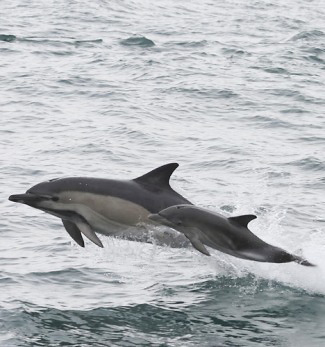

Common Dolphins by Chris Townend.
- A good chance of Sperm Whales
- And a great place for dolphins, including Bottlenose, Common, Risso's and Striped Dolphins
- A lesser chance of several other whales including Blue, Fin, Sei, Pilot and Cuvier's Beaked
- And even Loggerhead Turtle, flying fish and large predatory fish such as Blue Marlin, Sailfish and Swordfish
- As well as seabirds such as Bulwer's Petrel,
Grant's and Monteiro's Storm-petrels, and
Barolo and Cory's Shearwaters - All from large and fast semi-rigid inflatable boats or catamarans
- Which sail from these nine isolated volcanic islands in the Atlantic, with hot springs, geysers and crater lakes
- And a few landbirds including Canary, the endemic Azores Bullfinch and several other endemic forms of widespread European birds
- There is nothing quite like being in a small boat on the open ocean surrounded by dolphins surging through the clear water and sometimes leaping clear of it altogether. They seem so smooth and dynamic at the same time, and they may even move in to ride the boat’s bow wave, providing people on board with the chance to lean over and look them in the eye! It’s a pulsating experience, possible in many places around the world, but there are particularly high numbers and a rich variety of dolphins in the nutrient-rich deep waters surrounding the nine volcanic islands of the Azores about half way between Europe and North America in the middle of the north Atlantic. Bottlenose, Common, Risso’s and Striped are present all year round and during the summer they are joined by Spotted Dolphins, and any of these may be seen in large numbers and at close range. Most boats run out of the islands of Faial and Pico on which there are small watch towers called 'vigias', used by whalers up to 1987 but now by the local tour companies, and visitors, to spot the dolphins, as well as Sperm and other whales. Once spotted, the animals can be reached quickly in large semi-rigid inflatable boats like Zodiacs, or it is possible to travel more serenely on larger vessels such as catamarans.
Best Birds and other wildlife in the Azores
Mammals
Sperm Whale, and Bottlenose, (Short-beaked) Common, Risso’s, (Atlantic) Spotted
(mostly Jun-Sep) and Striped Dolphins. Also a chance of Blue, Fin, Sei (mostly Mar-Apr), Cuvier’s Beaked,
Sowerby’s Beaked, Northern Bottlenose, False Killer and (Short-finned) Pilot Whales. An impressive 28 species of
cetacean have been recorded in recent times. Also Azores Noctule, the world's only diurnal insectivorous bat.
Birds
Endemics 1
Azores Bullfinch (east Sao Miguel Island only).
Near-endemics
Azores, Madeira and Canary Islands 1 Island Canary.
Other specialities
Grant's (Band-rumped) Storm-petrel (breeds mainly October-early December to February-April, the 'cool' season), Monteiro's
(Band-rumped) Storm-petrel (breeds mainly late May-early June to September, the 'hot' season), Bulwer's Petrel (breeds
mainly May-September) and Barolo (Audubon's/Little/Macaronesian) Shearwater (breeds mainly January-May).
Others
Wilson's Storm-petrel, Cory’s Shearwater, Common and Roseate Terns, and azorean forms of (Common) Buzzard, Yellow-legged
Gull, (Common) Wood Pigeon, Grey Wagtail, (Eurasian) Blackbird, Goldcrest and Chaffinch. Also a chance of Fea's/Desertas
and Zino's Petrels, Great, Manx and Sooty Shearwaters, Cramp's (White-faced) Storm-petrel, Sabine’s Gull (mostly
Sep-Oct) and, especially in October, rare vagrant birds from North America, mainly on the western islands of Corvo and
Flores.
Reptiles, Amphibians and Fish
Loggerhead Turtle, Hammerhead Shark and flying fish. The
Azores are a popular game-fishing location since it is one of the best places in the world for Blue Marlin. Other
large fish which are caught regularly or may be seen leaping out of the ocean include White Marlin, Sailfish, Spearfish,
Swordfish, and Bluefin, Big-eye and Yellowfin Tunas (all mostly Jul-Sep). The islands are also popular with scuba-divers
in search of Devil Rays, schools of which gather here from July to October, especially at Baixa do Ambrosio, Santa Maria,
and Blue Sharks around the island of Pico from June to September.
Best Sites for Birds, dolphins, whales and other wildlife in the Azores
Boat trips, mainly for whales and dolphins, run out of the islands of Faial, Graciosa and Pico (Lajes des Pico). The Terceira-Graciosa ferry crossing is good for cetaceans and seabirds but the best place, especially for seabirds, is the Bank of Fortune off Gracisoa.
The endemic Azores Bullfinch occurs on the island of Sao Miguel only.
Best Times for Birds, dolphins, whales and other wildlife in the Azores
Sperm Whale, and Bottlenose, Common, Risso’s and Striped Dolphins are resident in the deep waters of The Azores but the main season lasts from mid-April to mid-October and the best time to go is August-September when Sperm Whales have calves. Spotted Dolphin is also present at this time, being a summer visitor present from June to September. Large whales such as Blue, Fin and Sei usually pass through in March-April.
Recommended Bird Books etc. for the Azores
Whales, Dolphins and Seals by H Shirihai. A & C Black Publishers, 2006.
Mammals of Europe, North Africa and the Middle East by S Aulagnier et al. Helm, 2009.
Mammals of Britain and Europe by D McDonald and P Barrett. Collins, 2005.
Seabirds: The New Identification Guide by P Harrison, M Perrow and H Larsson. Lynx, 2020.
Oceanic Birds of the World: A Photo Guide by S Howell and K Zufelt. PUP, 2019.
Field Guide to the Birds of Macaronesia by E Garcia-Del-Rey. Lynx Edicions, 2011.
Collins Bird Guide by L Svensson et al. Collins, 2010 (Second Edition).
Birds of Europe by L Jonsson. Helm, 1999.
Birds of the Atlantic Islands by T Clarke. Helm, 2006.
A Birdwatchers' Guide to Portugal, the Azores and Madeira Archipelagos by C Moore et al. Prion, 2014 (Second Edition).
Collins Butterfly Guide by T Tolman and R Lewington. Collins, 2009 (Third Edition).
Butterflies of Britain and Europe: A Photographic Guide by H Aarnio et al. A & C Black Publishers, 2009.
Apps etc.
Collins Bird Guide.
Birding and Whale Watching Trip Reports for the Azores
Many trip reports, some for the Azores, are posted on the websites listed here. On some of these websites some reports are independent and some are posted by tour companies who organize tours to the Azores. These tour companies and others also post their own reports on their websites, which are listed under 'Some Organized Tours to the Azores' below.
- The best website for trip reports is CloudBirders
- but these are also worth a look
- Birdtours
- Fatbirder
- Jon Hornbuckle
- Mammal Watching
Local bird and wildlife guides in the Azores
The costs of organized tours partly reflect the quality of the tour leaders. Some leaders are certainly better than others and many companies claim their leaders are the best but even the best rely at least to some extent on the exceptional skills of the local guides they employ. If you are travelling independently, employing such local guides will greatly increase your chances of seeing the wildlife you wish to see.
- Azores Nature
- A not-for-profit project with the aim of organising exploration/discovery trips to the Azores for serious birders/naturalists. Our aim is to lead focused itineraries which are cost effective in groups, and the emphasis on our trips is contributing to knowledge about Azores birds and wildlife.
Accommodation for birders and whale watchers in the Azores
Some Organized Tours for birds, whale watching and other wildlife to the Azores
There are many tour companies who organize tours to see mammals, birds, other wildlife and other natural wonders. The cost of these tours vary considerably according to such variables as the airlines used, the number of days the tours last, the number of sites visited, the number of people in the group (an important consideration if you wish to see such wildlife as rainforest mammals and birds), the number of tour leaders, the standard of accommodation and transport, and the percentage profit the company hopes to make. Generally, where the number of days tours last and the number of sites visited are similar, the cheapest tours are those that use the cheapest airlines, accommodation and local transport, that have the largest groups with the least number of leaders, and that make the least amount of profit. The most expensive tours tend to be those which are exceptionally long, use the most expensive accommodation (ridiculously lavish in some cases, even for single nights) and which make the most profit. Some tour costs partly reflect the quality of the tour leaders. Some leaders are certainly better than others and many companies claim their leaders are the best but even the best rely at least to some extent on the exceptional skills of the local guides they employ.
While tour companies organize tours with set itineraries many also organize custom tours for individuals and private groups who instead of taking a tour with a set itinerary want to follow their own itinerary to suit their own personal tastes, whether it be mammals, birds, other wildlife, other natural wonders or even man-made attractions, or a mixture of them all. Many organized tours with set itineraries are also fast-paced and target as many species as possible, whether they are mammals, birds or other wildlife or everything, which usually leaves little time to enjoy the best sites and individual species, but on a custom tour those taking part can specify the pace and the sites and species they wish to concentrate on. Custom tours also suit people who like to travel with people they already know, rather than with a group of strangers, and they are popular with people with partners with different interests. Individuals, partners and small groups will almost certainly have to pay more for a custom tour than an organized tour with a set itinerary but a large group of friends may be able to travel for less than the price quoted for a set tour.
Tour companies who run organized tours to the Azores include the following. Many of these also offer custom tours.
- Birdfinders
- Naturetrek
- Wildlife Worldwide
- Wise Birding Holidays
- We are a small wildlife watching holiday company based in Devon (UK) specialising in birdwatching and mammal watching holidays across the world. What sets us apart from other wildlife watching companies is quite simple:
- 1 – small group sizes: (average between 4 – 8 people)
- 2 – a commitment to conservation: (donation after each tour)


